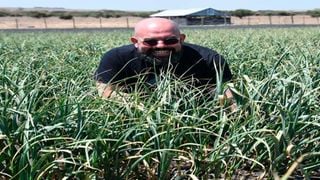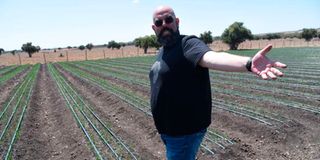
Gilad Millo at his Garlic farm at Isinya in Kajiado County on September 28, 2021.
| Evans Habil | Nation Media GroupSeeds of Gold
Premium
Gilad Millo’s new song on garlic farming
What you need to know:
- The one time deputy ambassador of Israel has been farming garlic for the last two years.
- Gilad’s love for agriculture goes beyond the few years he has been practising garlic farming.
Gilad Millo is a man who keeps on adding different feathers in his cap. Once a deputy ambassador of Israel, the singer is now juggling music with garlic farming.
It is two years since he went into garlic farming, growing the crop on his five-acre Ole Raha Farm in Isinya, Kajiado County.
“I farm the African Giant and Rwanda varieties, which are strong, resistant and yield very beautiful and tasty garlic that has powerful smell and is excellent for cooking,” says Gilad, who farms the crop under irrigation.
He farms with business partner Tewedros Kassa from Ethiopia, where garlic is common. Both of them have agricultural experience.
“In my case, I worked eight years at Amiran Kenya while my partner is an expert garlic grower with years of experience,” he says.
A good garlic crop starts with seeds, which must be properly germinated, he offers.
“Germinating the seeds (cloves) needs precision and care, making sure they are exposed to correct temperatures so that they sprout immediately after planting. The biggest mistake people make is to try to plant freshly harvested garlic by drying it and breaking it up; that can never achieve good results.”
The seeds are planted at 3cm depth with the root side facing down and gently covered with a thin layer of soil. Irrigation should follow immediately after planting.
“Throughout the season, several fertilisers and foliars are applied. In principle, garlic requires phosphorus in its early stages, nitrogen in the middle of the season and potassium closer to the end.” According to Gilad, though garlic is a hardy crop, one still needs to keep an eye out for diseases and disease.
“It’s important to provide good nutrition and feeding for the crop throughout the season.”
The garlic season lasts four months from planting to harvesting.
“Close to the end of the season when four to six months, lower leaves turn yellow and one should stop watering. When the stem falls to the side, we know it is time to harvest.”
Harvesting is a lot of work, says Gilad. It’s thus important for one wait until the crop is fully mature.
“After harvesting, cure the plants by hanging them, still with the stems, until they dry. Then cut, clean and prepare for market.”
So far, they have had four harvests, including after intercropping the crop with beans.
“We stagger our planting so that we are always planting on a certain block and harvesting on another.”

Gilad Millo at his Garlic farm at Isinya in Kajiado County on September 28, 2021.
In the initial investment, it took them up to Sh350,000 per acre to produce garlic. But he says this was because of the initial set up, which included things like fencing, structures, water tanks and stand and the irrigation system.
Then there are the seasonal costs like seeds, fertilisers and labour, which, however, are recouped over time from the investment as there is huge market for garlic.
“Though most garlic is imported, including from China, there is still a big room for our garlic in the market because Kenyans are big consumers of the produce.”
But growing garlic has challenges, he says.
“In our case, the previous season was challenging because this area suffered a lengthy cold spell, which is problematic as it brings diseases such as purple blotch and rust. Luckily, we caught them in time and prevented the spread and still enjoyed an excellent harvest.”
Garlic do well in altitudes of between 500-2,000m above sea level. The best temperature for production is 12-24 degrees Celsius. Very high temperatures, humidity and rainfall interfere with garlic production.
Gilad’s love for agriculture goes beyond the few years he has been practising garlic farming. He has worked in the agriculture sector for many years.
“When I was deputy ambassador of Israel in Kenya years ago, I was involved in the famed Kibwezi Irrigation Project and gained experience working with drip irrigation through the aid agency Mashav all over East Africa,” says the Unajua singer
Later, he worked for Amiran Kenya, where he focused on youth-led agribusinesses, training the farmers on how to make profit from their farms.
“Today at Ole Raha, I am much more hands on, spending time daily learning and experiencing the crop and of course singing to the garlic as it grows,” he quips.

Gilad Millo with his employees at his garlic farm at Isinya in Kajiado County on September 28, 2021.
He is lucky that a few months before the Covid-19 pandemic hit the country in March 2020, he had started the farm with a friend.
“When everything shut down soon after March 2020 because of the pandemic, we dedicated our time to the farm.”
Besides growing garlic, the duo is also working with a number of farmers across the country.
“We provide them with quality germinated seeds, train them on good crop management practices and guide them throughout the season. Later, we buy the produce at the end of the season. All of this is agreed in a contract.”
The produce is sold to supermarkets and groceries in Nairobi as well as to individuals who express an interest such as mama mbogas.
As he juggles music and farming, Gilad’s secret has always been time management. “I am very passionate about what I do and that drives me. I sleep four to five hours a night and make very good use of my time.”
According to him, garlic farming is becoming popular among farmers, and it is just a matter of time before local produce dominates the market.
His advice to any prospective garlic farmer is: “Do your homework. Understand what to expect in terms of costs, risks, challenges and treat your farm as you would any other business; calculating expenses and planning your next steps. Most importantly, don’t expect easy money.”
Carol Mutua, a crop specialist at Egerton University, says for garlic to grow well, soils should be fertile, well-drained and light with a pH of 5.5 to 6.8.
“Avoid heavy clay soils as they interfere with bulb development.”
For those who cannot afford to set up an irrigation system, Mutua says, one can successfully farm garlic even without it.
“You can sprinkle your crops with water every week. If grown under irrigation, garlic requires water during the early stages of development. Later, it needs little water because waterlogging will lead to rotting of the bulbs.”
And as he makes a mark in garlic farming, Gilad says his love for music is still intact. So, should fans expect new music, “Oh yes,” he says, as he peels a bulb of garlic, smelling the aroma.





